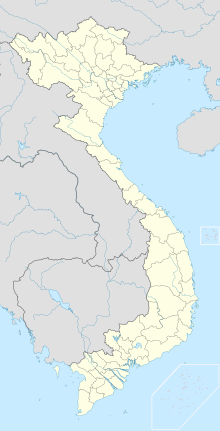| Battle of Dien Bien Phu | |||||||
|---|---|---|---|---|---|---|---|
| Part of the First Indochina War | |||||||
 Viet Minh troops planting their flag over the captured French headquarters at Dien Bien Phu | |||||||
| |||||||
| Belligerents | |||||||
|
| |||||||
| Commanders and leaders | |||||||
|
|
| ||||||
| Strength | |||||||
|
13 March: ~9,000 combat personnel ~1,800 logistics and support personnel 10 tanks 7 May: ~12,000 combat personnel ~2,000 logistics and support personnel ~600 aircraft |
13 March: ~15,000 logistics and support personnel[5] 7 May: | ||||||
| Casualties and losses | |||||||
|
1,571[6]–2,293[7] dead 1,729 missing[8] 11,721 captured[9](including 4,436 wounded)[10] 62 aircraft[11] and 10 tanks lost 167 aircraft damaged[12] |
Western historians estimate: 8,000 dead 15,000 wounded[13] Vietnamese figures: 13,930 casualties[14] Asian historians estimate: 23,000[15]–25,000[16] | ||||||
Location within Vietnam | |||||||
The Battle of Điện Biên Phủ was a climactic confrontation of the First Indochina War that took place between 13 March and 7 May 1954. It was fought between the French Union's colonial Far East Expeditionary Corps and Viet Minh communist revolutionaries.
The French began an operation to insert, and support, their soldiers at Điện Biên Phủ, deep in the autonomous Tai Federation in northwest Tonkin. The operation's purpose was to cut off enemy supply lines into the neighboring Kingdom of Laos (a French ally) and draw the Viet Minh into a major confrontation in order to cripple them. The French based their forces in an isolated but well-fortified camp that would be resupplied by air, a strategy adopted based on the belief that the Viet Minh had no anti-aircraft capability.
The Viet Minh, however, under General Võ Nguyên Giáp, surrounded and besieged the French. They brought in vast amounts of heavy artillery (including anti-aircraft guns) and managed to move these bulky weapons through difficult terrain up the rear slopes of the mountains. They dug tunnels and arranged the guns to target the French positions. The tunnels featured a front terrace, onto which the Viet Minh would pull their cannons from out of the tunnels, fire a few shots, to then pull them back into protective cover. In 54 days of gun battle, no Viet Minh cannon was destroyed.
In March, the Viet Minh began a massive artillery bombardment of the French defenses. The strategic positioning of their artillery made it nearly impervious to French counter-battery fire. Tenacious fighting on the ground ensued, reminiscent of the trench warfare of World War I. At times, the French repulsed Viet Minh assaults on their positions while supplies and reinforcements were delivered by air. As key positions were overrun, the perimeter contracted, and the air resupply on which the French had placed their hopes became impossible as aircraft were shot down and runways were destroyed.
The garrison was overrun in May after a two-month siege, and most of the French forces surrendered. A few men escaped to Laos. Among the 11,721 French troops captured, 858 of the most seriously wounded were evacuated via the Red Cross mediation in May 1954. Only 3,290 were returned four months later.[10] The French government in Paris resigned. The new prime minister, the left-of-centre Pierre Mendès France, supported French withdrawal from Indochina.
The Battle of Điện Biên Phủ was decisive. The war ended shortly afterward and the 1954 Geneva Accords were signed. France agreed to withdraw its forces from all its colonies in French Indochina, while stipulating that Vietnam would be temporarily divided at the 17th parallel, with control of the north given to the Viet Minh as the Democratic Republic of Vietnam under Ho Chi Minh. With huge support by the U.S., the south became the State of Vietnam, nominally under Emperor Bảo Đại, preventing Ho Chi Minh from gaining control of the entire country.[17]
- ^ Boylan & Olivier 2018, p. 286.
- ^ Riley 2014, pp. 194–95.
- ^ Cite error: The named reference
d224was invoked but never defined (see the help page). - ^ a b Cite error: The named reference
Franco_Embassy_2005was invoked but never defined (see the help page). - ^ Cite error: The named reference
d223was invoked but never defined (see the help page). - ^ Lam Quang Thi (2009). Hell in An Loc: The 1972 Easter Invasion. Denton TX: University of North Texas Press. p. 14. ISBN 978-1-57441-276-5.
- ^ Geoffrey Norman (January 2010). "What The French Lost At Dien Bien Phu". HistoryNet.
- ^ Hamilton-Merritt, Jane (1999). Tragic Mountains: The Hmong, the Americans, and the Secret Wars for Laos. Bloomington, IN: Indiana University Press. p. 62. ISBN 0-253-20756-8.
- ^ Of which ~3,000 will survive.
- ^ a b Cite error: The named reference
losseswas invoked but never defined (see the help page). - ^ "French Air Force in Vietnam text".
- ^ "Battle of Dien Bien Phu". HistoryNet. 12 June 2006.
- ^ Stone, p. 109
- ^ Ban tổng kết-biên soạn lịch sử, BTTM (1991). Lịch sử Bộ Tổng tham mưu trong kháng chiến chống Pháp 1945-1954. Ha Noi: Nhà xuất bản Quân Đội Nhân Dân. p. 799. (History Study Board of The General Staff (1991). History of the General Staff in the Resistance War against the French 1945–1954 (in Vietnamese). Ha Noi: People's Army Publishing House. p. 799.).
- ^ "ディエンビエンフーの戦い". 文教大学. 23 July 2009. Archived from the original on 7 September 2023. Retrieved 11 August 2023.
- ^ 國立政治大學歷史硏究所歷史學系 (1996). "國立政治大學歷史學報". 國立政治大學歷史學報 (13–14): 226.
- ^ Nash, Gary B., Julie Roy Jeffrey, John R. Howe, Peter J. Frederick, Allen F. Davis, Allan M. Winkler, Charlene Mires, and Carla Gardina Pestana. The American People, Concise Edition Creating a Nation and a Society, Combined Volume (6th Edition). New York: Longman, 2007.
